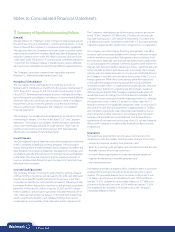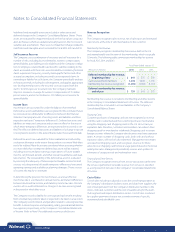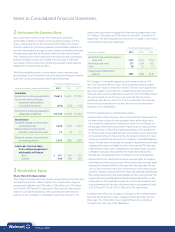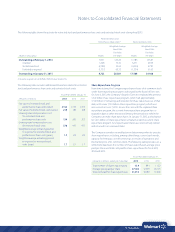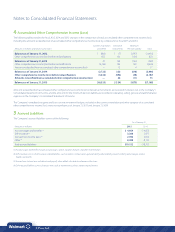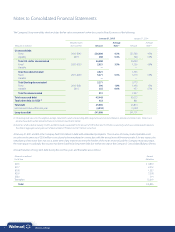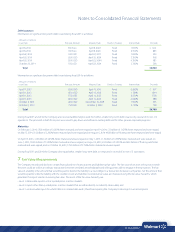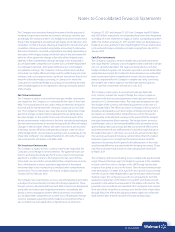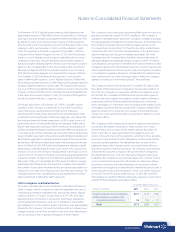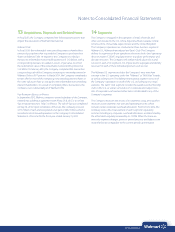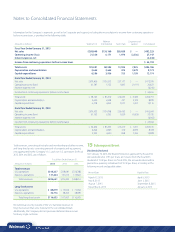Walmart 2015 Annual Report Download - page 52
Download and view the complete annual report
Please find page 52 of the 2015 Walmart annual report below. You can navigate through the pages in the report by either clicking on the pages listed below, or by using the keyword search tool below to find specific information within the annual report.
50 2015 Annual Report
Recurring Fair Value Measurements
The Company holds derivative instruments that are required to be measured at fair value on a recurring basis. The fair values are the estimated
amounts the Company would receive or pay upon termination of the related derivative agreements as of the reporting dates. The fair values have
been measured using the income approach and Level 2 inputs, which include the relevant interest rate and foreign currency forward curves.
As of January 31, 2015 and 2014, the notional amounts and fair values of these derivatives were as follows:
January 31, 2015 January 31, 2014
(Amounts in millions) Notional Amount Fair Value Notional Amount Fair Value
Receive fixed-rate, pay variable-rate interest rate swaps
designated as fair value hedges $ 500 $ 12 $1,000 $ 5
Receive fixed-rate, pay fixed-rate cross-currency interest rate swaps
designated as net investment hedges 1,250 207 1,250 97
Receive fixed-rate, pay fixed-rate cross-currency interest rate swaps
designated as cash flow hedges 4,329 (317) 3,004 453
Receive variable-rate, pay fixed-rate interest rate swaps
designated as cash flow hedges 255 (1) 457 (2)
Receive variable-rate, pay fixed-rate forward starting interest rate swaps
designated as cash flow hedges — — 2,500 166
Total $6,334 $ (99) $8,211 $719
Nonrecurring Fair Value Measurements
In addition to assets and liabilities that are recorded at fair value on a recurring basis, the Company’s assets and liabilities are also subject to
nonrecurring fair value measurements. Generally, assets are recorded at fair value on a nonrecurring basis as a result of impairment charges.
The Company did not record any significant impairment charges to assets measured at fair value on a nonrecurring basis during the fiscal years
ended January 31, 2015, or 2014.
Other Fair Value Disclosures
The Company records cash and cash equivalents and short-term borrowings at cost. The carrying values of these instruments approximate their
fair value due to their short-term maturities.
The Company’s long-term debt is also recorded at cost. The fair value is estimated using Level 2 inputs based on the Company’s current incremental
borrowing rate for similar types of borrowing arrangements. The carrying value and fair value of the Company’s long-term debt as of January 31, 2015
and 2014, are as follows:
January 31, 2015 January 31, 2014
(Amounts in millions) Carrying Value Fair Value Carrying Value Fair Value
Long-term debt, including amounts due within one year $45,896 $56,237 $45,874 $50,757
8 Derivative Financial Instruments
The Company uses derivative financial instruments for hedging and
non-trading purposes to manage its exposure to changes in interest and
currency exchange rates, as well as to maintain an appropriate mix of
fixed- and variable-rate debt. Use of derivative financial instruments in
hedging programs subjects the Company to certain risks, such as market
and credit risks. Market risk represents the possibility that the value of the
derivative financial instrument will change. In a hedging relationship, the
change in the value of the derivative financial instrument is offset to a
great extent by the change in the value of the underlying hedged item.
Credit risk related to a derivative financial instrument represents the pos-
sibility that the counterparty will not fulfill the terms of the contract. The
notional, or contractual, amount of the Company’s derivative financial
instruments is used to measure interest to be paid or received and does
not represent the Company’s exposure due to credit risk. Credit risk is
monitored through established approval procedures, including setting
concentration limits by counterparty, reviewing credit ratings and requiring
collateral (generally cash) from the counterparty when appropriate.
The Company only enters into derivative transactions with counterparties
rated “A-” or better by nationally recognized credit rating agencies.
Subsequent to entering into derivative transactions, the Company regu-
larly monitors the credit ratings of its counterparties. In connection with
various derivative agreements, including master netting arrangements,
the Company held cash collateral from counterparties of $323 million
and $641 million at January 31, 2015 and January 31, 2014, respectively.
The Company records cash collateral received as amounts due to the
counterparties exclusive of any derivative asset. Furthermore, as part
of the master netting arrangements with these counterparties, the
Company is also required to post collateral if the Company’s net
derivative liability position exceeds $150 million with any counterparty.
The Company did not have any cash collateral posted with counterparties
at January 31, 2015 or January 31, 2014. The Company records cash
collateral it posts with counterparties as amounts receivable from those
counterparties exclusive of any derivative liability.
Notes to Consolidated Financial Statements


